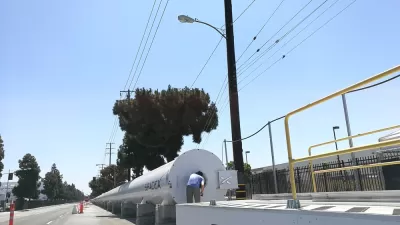About that Hyperloop report…

Aaron Gordon spoke to a number of transit and transportation experts and produces scathing criticism of the recent Great Lakes Hyperloop feasibility study released earlier this week.
The study, published by the Northeast Ohio Areawide Coordinating Agency and Hyperloop Transportation Technologies, estimated the price of the project at $29.8 billion and called for more studies of the project. Studies will be necessary, according to Gordon, because Hyperloop technology is totally unproven.
As such, a Hyperloop feasibility study is a strange document, somewhat like studying the conservation of the unicorn population after a few people strapped a horn onto a horse. As of this writing, Hyperloops have not transported any humans. The maximum speed a test pod has reached is 288 mph, well short of the advertised maximum velocity of 650 mph, or 700, or even 750 (the number varies article by article, not exactly a reassuring testament to the precision of their estimates).
The argument in favor of the Hyperloop doesn't just stop at travel speeds. The feasibility report also touts lofty economic development and job creation figures. There's a very large problem with those estimates, according to Gordon.
That all sounds real good except it’s also totally unclear how they arrived at these numbers. Despite the study’s 156-page length, it is extremely light on methodology or the assumptions baked into the calculations. In fact, any mention of study methodology or assumptions directs inquiring minds to an appendix. However, the feasibility study does not have an appendix, nor does the study’s landing page on NOACA’s website.
Gordon speaks to a number of experts who also noticed those discrepancies in the report, and they all express unequivocal caution at the idea that Hyperloop could possibly live up to the initial billing sold in the feasibility report.
Looming behind all of this Hyperloop discussion, are pressing needs on infrastructure and economic development investment that are already proven, and could provide tremendous benefit to the regions exploring the Hyperloop (the Great Lakes Hyperloop isn't the only one).
FULL STORY: Hyperloop Is The Midwest's Answer To A Question No One Asked

Planetizen Federal Action Tracker
A weekly monitor of how Trump’s orders and actions are impacting planners and planning in America.

Congressman Proposes Bill to Rename DC Metro “Trump Train”
The Make Autorail Great Again Act would withhold federal funding to the system until the Washington Metropolitan Area Transit Authority (WMATA), rebrands as the Washington Metropolitan Authority for Greater Access (WMAGA).

The Simple Legislative Tool Transforming Vacant Downtowns
In California, Michigan and Georgia, an easy win is bringing dollars — and delight — back to city centers.

The States Losing Rural Delivery Rooms at an Alarming Pace
In some states, as few as 9% of rural hospitals still deliver babies. As a result, rising pre-term births, no adequate pre-term care and "harrowing" close calls are a growing reality.

The Small South Asian Republic Going all in on EVs
Thanks to one simple policy change less than five years ago, 65% of new cars in this Himalayan country are now electric.

DC Backpedals on Bike Lane Protection, Swaps Barriers for Paint
Citing aesthetic concerns, the city is removing the concrete barriers and flexposts that once separated Arizona Avenue cyclists from motor vehicles.
Urban Design for Planners 1: Software Tools
This six-course series explores essential urban design concepts using open source software and equips planners with the tools they need to participate fully in the urban design process.
Planning for Universal Design
Learn the tools for implementing Universal Design in planning regulations.
Smith Gee Studio
City of Charlotte
City of Camden Redevelopment Agency
City of Astoria
Transportation Research & Education Center (TREC) at Portland State University
US High Speed Rail Association
City of Camden Redevelopment Agency
Municipality of Princeton (NJ)




























